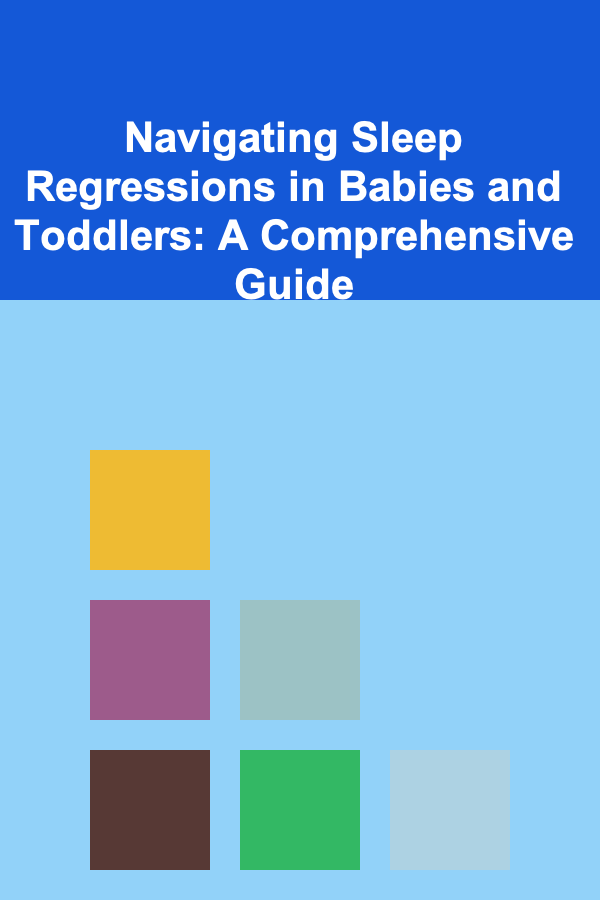
Navigating Sleep Regressions in Babies and Toddlers: A Comprehensive Guide
ebook include PDF & Audio bundle (Micro Guide)
$12.99$9.99
Limited Time Offer! Order within the next:

Sleep regressions are a common, albeit frustrating, experience for parents of babies and toddlers. These periods of disrupted sleep can leave both the child and the caregiver exhausted. Understanding the causes of sleep regressions, recognizing the signs, and implementing effective strategies to manage them is crucial for maintaining a healthy sleep environment for everyone involved. This comprehensive guide delves into the complexities of sleep regressions, offering practical advice and insights to help you navigate these challenging phases.
What is a Sleep Regression?
A sleep regression is a period, typically lasting between one to four weeks, where a baby or toddler who was previously sleeping well suddenly experiences disrupted sleep patterns. This can manifest as:
- Increased night wakings
- Difficulty falling asleep at bedtime
- Shortened naps
- Early morning awakenings
- Increased fussiness and irritability
It's important to note that not all sleep disturbances are sleep regressions. Teething, illness, or temporary changes in routine can also disrupt sleep. A true sleep regression is usually linked to a developmental milestone or a significant shift in a child's cognitive or physical abilities.
Common Sleep Regression Ages
While sleep regressions can occur at any time, there are certain ages where they are more commonly observed. These ages often coincide with significant developmental leaps:
4-Month Sleep Regression
The 4-month sleep regression is often considered the "real" sleep regression because it's a permanent change in a baby's sleep cycle. Prior to this age, babies spend a significant portion of their sleep in active (REM) sleep. Around 4 months, their sleep cycles mature and become more similar to those of adults, with transitions between sleep stages. These transitions can be disruptive, leading to more frequent awakenings. Babies may not know how to connect these sleep cycles independently and therefore wake fully needing assistance back to sleep.
Key Factors:
- Maturation of sleep cycles
- Increased alertness and awareness of surroundings
- Developing motor skills (rolling over)
6-Month Sleep Regression
While some consider this a continuation of the 4-month regression, the 6-month mark often brings new challenges. Babies are becoming more mobile (sitting up, crawling), and their cognitive abilities are developing rapidly. This can lead to increased separation anxiety and a greater awareness of their environment, making it harder to settle down for sleep.
Key Factors:
- Increased mobility (sitting, crawling)
- Solid food introduction
- Increased separation anxiety
8-10 Month Sleep Regression
This regression often coincides with significant cognitive leaps. Babies are developing object permanence (understanding that things still exist even when they can't see them), which can increase separation anxiety. They may also be learning to pull themselves up to stand or even cruise along furniture.
Key Factors:
- Development of object permanence
- Increased separation anxiety
- Learning to pull up to stand
12-Month Sleep Regression
The 12-month sleep regression is often linked to the excitement and cognitive development associated with learning to walk. Babies are also starting to understand more words and may be experiencing separation anxiety as they become more independent.
Key Factors:
- Learning to walk
- Increased language comprehension
- Continued separation anxiety
- Transitioning to one nap.
18-Month Sleep Regression
This is a common regression that often involves significant emotional and cognitive changes. Toddlers are developing their independence and asserting their will. They may resist bedtime routines and experience heightened separation anxiety. Language skills are also developing rapidly, which can lead to nightmares and night terrors.
Key Factors:
- Increased independence and assertiveness
- Rapid language development
- Potential for nightmares and night terrors
- Moving to a toddler bed.
2-Year Sleep Regression
The 2-year sleep regression is often characterized by increased tantrums and defiance, as toddlers are testing boundaries and asserting their independence. Potty training can also disrupt sleep patterns during this period.
Key Factors:
- Increased tantrums and defiance
- Potty training
- Development of imagination and potential for nightmares
- Dropping the daytime nap.
Identifying a Sleep Regression
It's important to differentiate a sleep regression from other sleep disturbances. Look for these signs:
- Sudden change in sleep patterns: A previously good sleeper suddenly starts waking frequently.
- Consistency: The sleep disruption lasts for several days or weeks.
- Age-appropriateness: The disruption occurs around common regression ages.
- Developmental milestones: The disruption coincides with a significant developmental leap.
- Rule out other causes: Ensure that illness, teething, or changes in routine are not the primary cause.
Strategies for Managing Sleep Regressions
While sleep regressions can be challenging, there are several strategies you can implement to help your child (and yourself) get through them:
1. Maintain a Consistent Routine
Consistency is key. A predictable bedtime routine signals to your child that it's time to wind down and prepare for sleep. This routine should be calming and relaxing, and should be followed every night, even during sleep regressions.
Example Bedtime Routine:
- Bath time
- Put on pajamas
- Brush teeth
- Read a book
- Sing a lullaby
- Tuck in and say goodnight
Similarly, maintain a consistent wake-up time and nap schedule. Even if your child has a rough night, try to stick to their regular sleep schedule as much as possible.
Tip:
Write down your bedtime routine and post it somewhere visible. This helps ensure consistency and allows other caregivers to follow the same steps.
2. Create a Conducive Sleep Environment
The sleep environment plays a crucial role in promoting restful sleep. Ensure that your child's room is:
- Dark: Use blackout curtains to block out light.
- Quiet: Use a white noise machine or fan to mask disruptive sounds.
- Cool: Maintain a comfortable temperature (around 68-72°F).
- Safe: Remove any potential hazards from the crib or room.
Consider using a sleep sack or wearable blanket for babies to provide a sense of security and warmth, and to prevent them from kicking off blankets. For toddlers, a comfortable and familiar blanket or stuffed animal can be comforting.
3. Avoid Creating New Sleep Associations
Sleep associations are things that your child associates with falling asleep. These can be positive (e.g., a pacifier, a favorite blanket) or negative (e.g., being rocked to sleep, being fed to sleep). During a sleep regression, it's tempting to resort to these negative sleep associations to get your child back to sleep, but this can create long-term sleep problems.
If you are consistently rocking, feeding, or holding your child to sleep, they may become dependent on these actions and struggle to fall asleep independently. Instead, aim to put your child down drowsy but awake, so they can learn to fall asleep on their own.
4. Offer Comfort and Reassurance
While it's important to avoid creating new sleep associations, it's also crucial to offer comfort and reassurance to your child during a sleep regression. Respond to their cries and let them know you are there for them. However, try to avoid picking them up immediately unless they are truly distressed.
Instead, try:
- Patting their back
- Shushing them softly
- Singing a lullaby
- Offering a comforting word
These actions can provide reassurance without creating a dependency on being held or rocked to sleep.
5. Evaluate Your Child's Feeding Schedule
Hunger can often be a cause of night wakings, especially during a sleep regression. Ensure that your child is getting enough calories during the day. For babies, this may involve increasing the frequency or amount of feedings. For toddlers, ensure they are eating a balanced diet with sufficient protein and healthy fats.
However, avoid feeding your child every time they wake up during the night. This can create a sleep association and lead to more frequent wakings. If your child is consistently waking up hungry, consult with your pediatrician or a registered dietitian to ensure they are meeting their nutritional needs.
6. Consider Sleep Training Methods
If the sleep regression persists for more than a few weeks and is significantly impacting your family's well-being, you may consider implementing a sleep training method. There are various sleep training methods available, ranging from gentle approaches to more structured techniques.
Common Sleep Training Methods:
- Cry It Out (CIO): This method involves putting your child to bed and allowing them to cry until they fall asleep. While controversial, it can be effective for some children. It's important to consult with your pediatrician before implementing this method.
- Ferber Method (Gradual Extinction): This method involves checking on your child at gradually increasing intervals when they cry. This allows you to offer reassurance without picking them up.
- Chair Method: This method involves sitting in a chair next to your child's crib or bed until they fall asleep. Over time, you gradually move the chair further away from the bed until you are out of the room.
- Pick-Up/Put-Down Method: This method involves picking up your child when they cry, comforting them until they are calm, and then putting them back down in the crib or bed. You repeat this process until they fall asleep.
The best sleep training method for your child will depend on their temperament, age, and your parenting style. Research different methods and choose one that you feel comfortable with. It's important to be consistent with your chosen method to see results.
7. Be Patient and Consistent
Sleep regressions can be exhausting and frustrating for parents. It's important to remember that they are temporary phases and that with patience and consistency, you will get through them. Avoid making drastic changes to your routine or sleep training method unless necessary. Give your child time to adjust to the new routine or method.
Remember to take care of yourself during this time. Get enough rest when you can, eat healthy, and ask for help from your partner, family, or friends. A well-rested and supported caregiver is better equipped to handle the challenges of a sleep regression.
8. Rule Out Medical Issues
If your child's sleep disturbance is severe or prolonged, it's important to rule out any underlying medical issues. Consult with your pediatrician to discuss your concerns and to rule out any potential medical causes, such as:
- Ear infections
- Allergies
- Reflux
- Sleep apnea
9. Managing Toddler Sleep Regressions Specifically
Toddler sleep regressions require a slightly different approach due to their increased cognitive abilities and independence. Here are some tips tailored for managing sleep regressions in toddlers:
- Set Clear Boundaries: Toddlers thrive on routine and clear boundaries. Enforce bedtime rules consistently.
- Offer Choices (Within Limits): Give your toddler a sense of control by offering limited choices, such as which pajamas to wear or which book to read.
- Use Positive Reinforcement: Reward good sleep behavior with praise, stickers, or small non-food rewards.
- Address Fears and Anxieties: Talk to your toddler about any fears or anxieties they may be experiencing. Use a nightlight or a comforting toy to help them feel secure.
- Limit Screen Time Before Bed: The blue light emitted from screens can interfere with sleep. Avoid screen time for at least an hour before bedtime.
- Avoid Over-Tiredness: Ensure your toddler is getting enough daytime sleep and that they are not overly tired at bedtime. Over-tiredness can actually make it harder for them to fall asleep.
10. The Role of Naps
Naps can be a significant factor in sleep regressions. During a sleep regression, naps may be shorter or skipped altogether. It's important to maintain a consistent nap schedule, even if your child is resisting naps. Over-tiredness can worsen sleep regressions. Adjusting nap times may be necessary during these phases. For example, shifting the nap earlier may alleviate some of the night waking symptoms.
Be aware of signs of readiness to transition from two naps to one, or from one nap to none. These transitions can temporarily disrupt sleep, but are often a sign of healthy development. Consult with your pediatrician or a sleep consultant if you are unsure whether your child is ready for a nap transition.
When to Seek Professional Help
While most sleep regressions are temporary and resolve on their own, there are times when it's necessary to seek professional help. Consider consulting with your pediatrician, a sleep consultant, or a child psychologist if:
- The sleep regression persists for more than a few weeks and is significantly impacting your family's well-being.
- Your child is exhibiting signs of a sleep disorder, such as sleep apnea or restless legs syndrome.
- You are struggling to implement effective sleep strategies on your own.
- You are experiencing significant stress or anxiety related to your child's sleep.
- You suspect an underlying medical or psychological issue is contributing to the sleep disturbance.
Conclusion
Sleep regressions are a normal part of child development. While they can be challenging and exhausting, understanding the causes, recognizing the signs, and implementing effective strategies can help you navigate these phases and maintain a healthy sleep environment for your child. Remember to be patient, consistent, and to prioritize your own well-being during this time. With the right approach, you and your child can get through sleep regressions and back to restful nights.

How to Increase the Value of Your Investment Property
Read More
How To Stay Ahead of the Next Big Fashion Trend
Read More
How to Find Cheap Flights to Anywhere
Read More
How to Explore the World of Craniosacral Therapy
Read More
Mastering Negotiation in Board Games: A Deep Dive
Read More
How to Fold Origami Animals for Beginners
Read MoreOther Products

How to Increase the Value of Your Investment Property
Read More
How To Stay Ahead of the Next Big Fashion Trend
Read More
How to Find Cheap Flights to Anywhere
Read More
How to Explore the World of Craniosacral Therapy
Read More
Mastering Negotiation in Board Games: A Deep Dive
Read More